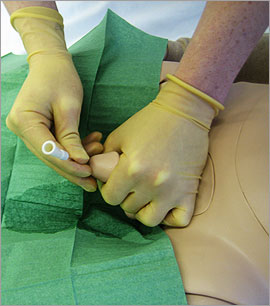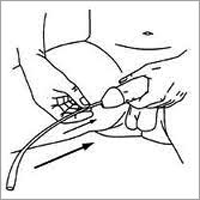After washing yourself with mild soap and water proceed as follows :
Self-catheterisation step by step
For women and girls only
- When you have assembled all the things you need (see above) and taken off any clothes that get in the way, wash your hands well with soap, and rinse and dry them.
- Sit (on the toilet if this is possible and comfortable) so that you have both hands free.
- If you are menstruating wash the urethra if necessary. Use a flannel and warm water and, after separating the labia, wash in a downward direction from front to back.
- Squeeze a little lubricating jelly onto a tissue and discard it. Squeeze a little more and put it on the rounded tip of the catheter.
- Check that the other end of the catheter is in the container or towards the toilet so that you won't spill any urine.
- Open the labia with two fingers of one hand and then with the other gently push the catheter into the urethra. Keep pushing until urine begins to come out. Just before the catheter enters the bladder it may seem to get stuck as it meets the tightly closed sphincter muscle. This is normal and if you keep pushing gently the catheter will pass through the sphincter.
- If you have spent time learning to locate your urethra, using a mirror you will probably not accidentally insert the catheter into your vagina. But if you do, don't worry. Just rinse the catheter in warm water, put on more lubricating jelly and start again.
- When the flow of urine stops, press gently low down on your tummy, just above the pubic bone. This will help squeeze out any remaining urine. You may find changing your position helps.
- When no more urine comes out of the catheter, slowly remove it, and if more urine begins to come, wait for the flow to stop before taking the catheter right out. Hold both ends of the catheter up after removing it so that no urine can drip out.
- Rinse the catheter carefully under a running tap. Dry it and replace it in its plastic envelope.
For men and boys only
A cross-section of the male anatomy
In men, the urethra is 10-15 cm long and shaped like the letter S. When introducing the catheter the "s" is straightened out by lifting the penis towards the lower abdomen.
- When you have assembled all the things you need (see above) and have taken off any clothes that get in the way, wash your hands well with soap, and rinse and dry them. Sit (on the toilet if this is possible and comfortable) so that you have both hands free.
- Many men prefer to sit on the side of a firm bed or chair, in which case you will need a jug or some other receptacle to collect the urine. It may be helpful to lean back slightly.
- Squeeze a little lubricating jelly onto a tissue and discard it. Squeeze a little more and put it on the rounded tip of the catheter.
- Check that the other end of the catheter is in the container or towards the toilet so that you won't spill any urine.
- Pull back the foreskin. Hold your penis with one hand, straightening the J bend and with the other gently push the catheter into the urethra. Keep pushing until urine begins to come out. Just before the catheter enters the bladder it may seem to get stuck as it meets the tightly closed sphincter muscle. This is normal and if you keep pushing gently the catheter will pass through the sphincter.
- When the flow of urine stops, press gently low down on your tummy just above the pubic bone. This will help squeeze out any remaining urine. You may find changing your position helps this too.
- When no more urine comes out of the catheter slowly remove it, and if more urine begins to come out wait for the flow to stop before taking the catheter right out. Hold both ends of the catheter up after removing it so that no urine can drip out.
- Rinse the catheter carefully under a running tap. Dry it and replace it in its plastic envelope.
How often should the bladder be emptied?
This varies greatly from person to person, depending on :
- Reason for emptying the bladder
- The amount you drink
- Medications taken
This will be decided when you are taught ISC, and may very depending on the amount of urine you are passing each time.
Before emptying the bladder :
Always try to pass water by yourself. Relax your pelvic floor and sphincter muscles. Do not press down with your abdominal muscle. You may be able to stimulate passing water by running a tap at the same time.
When emptying the bladder :
To check whether the bladder is really empty press gently on your lower abdomen or move a little. It is very important that all the urine comes out of the bladder; this reduces the risk of a bladder infection.
Bowel habits :
It is important that bowels open regularly, i.e. on a daily basis. So eat a well balanced, diet with plenty of fruit and vegetables. If you become constipated, consult your doctor as this may interfere with ISC.
How much should I drink?
You should drink at least 6-8 cups of fluid every day - but keep to a minimum the amount of coffee and tea as these can irritate the bladder.
General Advice
If a few specks of blood appear do not worry they are due to irritation and should clear up in a few days. If the bleeding persists or becomes heavy then tell your doctor, or contact person.
If you have any of the following: -
- shivering high temperature/fever
- cloudy urine
- your urine smells offensive
you may have an infection. Drink extra fluids and contact your doctor.
If your catheter will not come out, leave it for a few moments and try again. If it still will not come out, cough, this will often loosen it. If you are still unable to remove the catheter call your doctor. Do not tug at the catheter.
If the catheter can not be inserted, have a bath to relax yourself and try again. This may happen initially when you are tense. If, after 4 hours from the last time you should have catheterized yourself, you have not been successful, call your doctor or ISC contact person.
If you are performing ISC for either Stricture Dilatation or Urinary Diversion
You may be given special instructions in these cases.
For small children
With small children whose parents have learned to empty the bladder it is best if the child is laid on a table. The urine can be run out into a nappy, urine bottle or bag. From the age of 4-5 children can gradually begin to empty their own bladders.
When traveling abroad
Ask your doctor for a letter stating that the catheters you are taking with you are for emptying the bladder. This can save you a lot of trouble with customs officials. If you are staying in a country where the drinking water may not be absolutely safe, we recommend you use bottled water. This may also be necessary in other situation, i.e. where there is no water at all.
How long can I use the same catheter?
The catheters used for ISC are technically described as semi-disposable, that is, they are designed to be washed and reused for a limited period-in this case, one week. They should always be rinsed in running water and properly dried after use, and between uses should be kept in the plastic envelope supplied with the pack of catheters. Some people find it convenient to have two catheters in use at any one time, one at home and one at school, college or place of work. The individual catheter should not be kept for longer than a week after being unwrapped from its original sealed sachet, even if it has not been used many times.
How often should catheterize yourself?
This is obviously something that varies both from person to person and from day to day. As you get experience with ISC, you will get used to your own usual pattern-how quickly your bladder fills up and how much difference it makes if you drink more than usual, taking a bit of exercise, etc. To begin with it's best to catheterize on waking and just before bed and about every two to three hours during the day.




